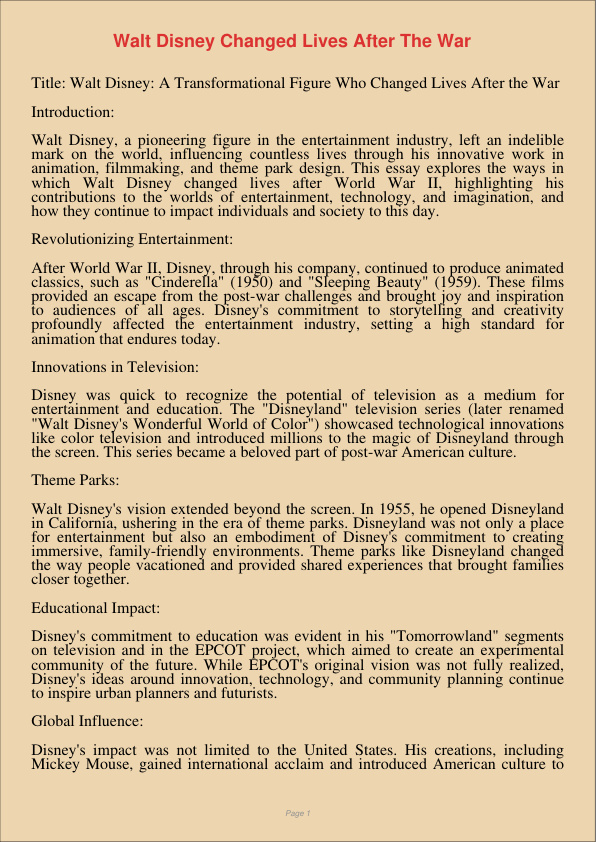Walt Disney Changed Lives After The War
Jan 9, 2024
walt disney changed lives
war
Religion and Theology
Marketing
Title: Walt Disney: A Transformational Figure Who Changed Lives After the War
Introduction:
Walt Disney, a pioneering figure in the entertainment industry, left an indelible mark on the world, influencing countless lives through his innovative work in animation, filmmaking, and theme park design. This essay explores the ways in which Walt Disney changed lives after World War II, highlighting his contributions to the worlds of entertainment, technology, and imagination, and how they continue to impact individuals and society to this day.
Revolutionizing Entertainment:
After World War II, Disney, through his company, continued to produce animated classics, such as “Cinderella” (1950) and “Sleeping Beauty” (1959). These films provided an escape from the post-war challenges and brought joy and inspiration to audiences of all ages. Disney’s commitment to storytelling and creativity profoundly affected the entertainment industry, setting a high standard for animation that endures today.
Innovations in Television:
Disney was quick to recognize the potential of television as a medium for entertainment and education. The “Disneyland” television series (later renamed “Walt Disney’s Wonderful World of Color”) showcased technological innovations like color television and introduced millions to the magic of Disneyland through the screen. This series became a beloved part of post-war American culture.
Theme Parks:
Walt Disney’s vision extended beyond the screen. In 1955, he opened Disneyland in California, ushering in the era of theme parks. Disneyland was not only a place for entertainment but also an embodiment of Disney’s commitment to creating immersive, family-friendly environments. Theme parks like Disneyland changed the way people vacationed and provided shared experiences that brought families closer together.
Educational Impact:
Disney’s commitment to education was evident in his “Tomorrowland” segments on television and in the EPCOT project, which aimed to create an experimental community of the future. While EPCOT’s original vision was not fully realized, Disney’s ideas around innovation, technology, and community planning continue to inspire urban planners and futurists.
Global Influence:
Disney’s impact was not limited to the United States. His creations, including Mickey Mouse, gained international acclaim and introduced American culture to the world. His influence reached far and wide, fostering a global love for animation and storytelling.
Continued Legacy:
Even after his passing in 1966, Disney’s legacy lived on through the expansion of his theme parks, the creation of new animated classics, and the acquisition of other influential entertainment companies, such as Pixar, Marvel, and Lucasfilm. These acquisitions have allowed Disney to remain at the forefront of the entertainment industry, shaping the way stories are told and experienced.
Conclusion:
Walt Disney was a transformational figure who changed lives after World War II and continues to impact the world today. His contributions to the entertainment industry, innovations in technology, and commitment to storytelling and imagination have left an enduring legacy. Disney’s creations and vision have not only brought joy and inspiration to countless individuals but have also influenced the very fabric of society, shaping the way we experience, consume, and create entertainment. His impact remains an enduring testament to the power of imagination and the ability to change lives through creativity and innovation.
